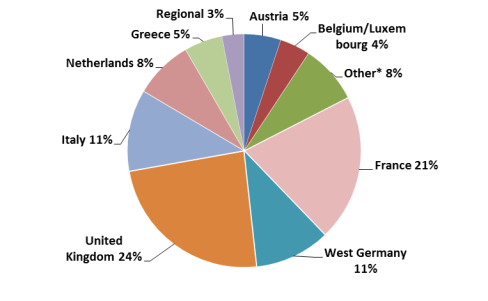The Marshall Plan: 70th Anniversary
June 5, 2017, marks the 70th anniversary of the Marshall Plan—considered by many to be one of the most successful foreign policy initiatives and foreign aid programs ever undertaken by the United States.
In a speech at Harvard University on June 5, 1947, Secretary of State George Marshall suggested that, if European countries working together came up with a proposal, the United States would be willing to provide assistance in response to the dire political, social, and economic conditions in which Europe found itself at that time. The speech set in motion a diplomatic and legislative train of events that led to the Economic Recovery Program (ERP), also known as the Marshall Plan, an ambitious effort to stimulate economic growth in a despondent and near-bankrupt post-World War II Europe, prevent the spread of communism beyond the "iron curtain," and encourage development of a healthy and stable world economy.
Objectives. The Marshall Plan was designed to accomplish these goals through achievement of three objectives:
- the expansion of European agricultural and industrial production;
- the restoration of sound currencies, budgets, and finances in individual European countries; and
- the stimulation of international trade among European countries and between Europe and the rest of the world.
Congressional Action. The Economic Cooperation Act of 1948 (P.L. 80-472), signed into law on April 3, 1948, resulted from close consultation between the Democratic Truman Administration and the Republican-led Congress, more than 50 days of congressional hearings, and numerous studies from think tanks and special government committees. It was, according to the Chairman of the Senate Foreign Relations Committee, Arthur Vandenberg, "the final product of 8 months of more intensive study by more devoted minds than I have ever known to concentrate upon any objective in all my 20 years in Congress."
Under the Marshall Plan, between 1948 and 1951, the United States provided $13.3 billion ($150 billion in 2017 dollars) in assistance to 16 European countries (Figure 1). The 1949 appropriation alone represented roughly 12% of the U.S. federal budget.
 |
|
Source: U.S. Agency for International Development, November 16, 1971. Note: Other* = Denmark, Iceland, Ireland, Norway, Portugal, Sweden, Turkey. |
Implementation
Most Marshall Plan assistance was provided in the form of grants so that countries could purchase U.S. products. This was meant to address the huge dollar deficits that prevented European countries from purchasing goods from the United States, at this point the only viable supplier of many industrial and agricultural goods. For every dollar provided to a country, that country had to match the contribution with a dollar's worth of its own currency which went into a counterpart fund. Those funds could then be used for infrastructure of benefit to that country.
A requirement that the U.S. Marshall Plan Administrator had to approve the use of counterpart funds for each infrastructure project gave the United States leverage to ensure that European countries would meet bilateral commitments to adopt economic policy reforms necessary to meet Marshall Plan objectives, such as balancing budgets and lowering tariffs on intra-European trade. But key to Marshall Plan success was the responsibility placed on European nations from the start to formulate their own solution to their mutual problems. European countries established the Organization of European Economic Cooperation (OEEC) to jointly support plan objectives and reinforce the sense of mutual responsibility for the success of the program. Among other obligations, the OEEC was charged by the United States with determining the division of grant aid among the 16 countries. It also worked to lower trade barriers and established a European Payments Union to act as a central clearinghouse for settlement of all payments transactions among members.
Other Marshal Plan activities included a technical assistance and exchange program that focused on increasing European business productivity and an effort to finance industrial projects (power, steel, transport) leveraging local private sector funds.
Achievements and Legacy
As evidenced by the periodic calls by prominent statesmen for new Marshall Plans—for the environment, for Africa, for refugees, etc.—in the years since its completion, the original plan has been viewed as an outstanding success. For one, a sense of political stability returned to Europe and communist parties did not take over Western European governments. On the economic front, much progress had been made by European countries. By the end of 1951, industrial production for all participating countries was 64% higher than in 1947. Total Gross National Product (GNP) rose by about 25%. The dollar deficit that had been a major issue at the start of the Marshall Plan dropped from $8 billion to about $2 billion in 1952 and into an approximate balance by 1953. Three-quarters of the intra-European import quota restrictions that Europeans had promised to address were eliminated by 1951. At the end of that year, trade volume within Europe was almost double that of 1947.
While some revisionist economists have argued variously that Europe was already recovering on its own in 1947 and did not require Marshall Plan assistance and/or that the Marshall Plan represented too small a proportion of each country's GNP to make a difference in their economic growth, there is universal agreement that the plan had a powerful political impact.
Historians believe that the give and take among European governments in the process of coming to decisions, such as the allocation of U.S. grants, helped mold the cooperation that led eventually to the establishment of the Coal and Steel Community in 1952 and later the European Community. The OEEC continued to deal with European economic issues through the 1950s and, joined by the United States in 1961, became the Organization for Economic Cooperation and Development (OECD). Overall, the Marshall Plan can be said to have strengthened the Western alliance and fortified it for the long Cold War ahead.
For further details, see CRS Report 97-62, The Marshall Plan: Design, Accomplishments, and Relevance to the Present.